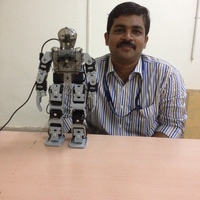Papers by Juliusz Modzelewski
PRZEGLĄD ELEKTROTECHNICZNY, 2015
ELEKTRONIKA - KONSTRUKCJE, TECHNOLOGIE, ZASTOSOWANIA, 2015
ELEKTRONIKA - KONSTRUKCJE, TECHNOLOGIE, ZASTOSOWANIA, 2014
Proceedings of the IEEE
Class-D voltage-switching tuned power amplifier circuits are presented, in which complementary pa... more Class-D voltage-switching tuned power amplifier circuits are presented, in which complementary pair transistors are used and bases of the transistors are coupled by a capacitor. These circuits have several advantages over previous circuits. They do not require a drive transformer and both transistors can be mounted on one heat sink.
A HF power amplifier used in drain amplitude modulator must have a linear static modulation chara... more A HF power amplifier used in drain amplitude modulator must have a linear static modulation characteristic i.e. linear dependence of amplifier HF output voltage vs. its supply voltage. This condition essential for obtaining low-level envelope distortions is theoretically met by a class-E amplifier. In this paper the influence of non-linear output capacitance of the transistor in the class-E amplifier on its static modulation characteristic is analyzed. Simulations with PSPICE of class-E amplifiers operating at frequencies 0.5 MHz, 5 MHz and 7 MHz have proven that distortions of the amplifier static modulation characteristic caused by non-linear output capacitance of the amplifier transistor are only slight. However, the decrease of power efficiency of the class E amplifier resulting from non-linearity of transistor output capacitance can be significant even by 40%.

A high-frequency power amplifier used in a drain amplitude modulator must have linear dependence ... more A high-frequency power amplifier used in a drain amplitude modulator must have linear dependence of output HF voltage V o V o V o versus its supply voltage V DD V DD V DD . This condition essential for obtaining low-level envelope distortions is met by a theoretical class-E amplifier with a linear shunt capaci-tance of the switch. In this paper the influence of non-linear output capacitance of the transistor in the class-E amplifier on its V o (V DD) V o (V DD) V o (V DD) characteristic is analyzed using PSPICE sim-ulations of the amplifiers operating at frequencies 0.5 MHz, 5 MHz and 7 MHz. These simulations have proven that distor-tions of the V o (V DD V o (V DD V o (V DD) characteristic caused by non-linear output capacitance of the transistor are only slight for all analyzed amplifiers, even for the 7 MHz amplifier without the external (linear) shunt capacitance. In contrast, the decrease of power efficiency of the class-E amplifier resulting from this effect can be significant...
Output power of transistorised high-power high-frequency converters can be controlled utilising t... more Output power of transistorised high-power high-frequency converters can be controlled utilising their specific structure consisting of a set of amplifiers the power of which is combined. The output power of such a converter can be controlled by varying the number of combined amplifiers versus the control signal. In the controlled power-combining network there can be used class-DE power amplifiers operating in zero-voltage-switching conditions, which assures high efficiency for any nonzero output power. The paper presents a theoretical analysis for a power-combining converter with class-DE amplifiers and experimental results obtained for a five-stage 500kHz/700W laboratory model. Advantages and limitations of the power-control method are also discussed.

A Class DE or Class D Zero-Voltage Switching amplifier is a high-efficiency, radio-frequency powe... more A Class DE or Class D Zero-Voltage Switching amplifier is a high-efficiency, radio-frequency power amplifier which also finds application in various power conversion industrial circuits such as dc/dc converters as well as dielectric and induction heaters. The output voltage (current or power) in these circuits can be controlled by varying the Class-DE-amplifier operating frequency and maintaining high efficiency over a wide range of output power. In the paper the computer-aided first-harmonic method is used to find relations defining parameters of the Class-DE amplifier vs. its operating frequency for the constant load resistance. It has been shown that by decreasing the operating frequency of the Class-DE-amplifier in the optimum mode its output voltage is increased. Unfortunately, then the efficiency is reduced because the transistors leave the ZVS region and their power losses rise. In contrast, by increasing the amplifier operating frequency its output voltage is decreased maint...

EUROCON 2007 - The International Conference on "Computer as a Tool", 2007
A Class DE or Class D Zero-Voltage Switching amplifier is a high-efficiency, radio-frequency powe... more A Class DE or Class D Zero-Voltage Switching amplifier is a high-efficiency, radio-frequency power amplifier which also finds application in various power conversion industrial circuits such as dc/dc converters as well as dielectric and induction heaters. The output voltage (current or power) in these circuits can be controlled by varying the Class-DE-amplifier operating frequency and maintaining high efficiency over a wide range of output power. In the paper the computer-aided first-harmonic method is used to find relations defining parameters of the Class-DE amplifier vs. its operating frequency for the constant load resistance. It has been shown that by decreasing the operating frequency of the Class-DE-amplifier in the optimum mode its output voltage is increased. Unfortunately, then the efficiency is reduced because the transistors leave the ZVS region and their power losses rise. In contrast, by increasing the amplifier operating frequency its output voltage is decreased maintaining the ZVS operation and high efficiency (sub-optimum mode). The operating frequency can be increased up to the value corresponding to the second optimum operation mode of the Class-DE amplifier. The theoretical results have been verified by computer simulation with SPICE program as well as by experimental tests carried out for 1MHz 265W Class-DE amplifier (measured efficiency exceeded 96%).
2006 International Conference on Microwaves, Radar & Wireless Communications, 2006
ABSTRACT One of basic problems in a Class E amplifier operating at a high frequency is an appropr... more ABSTRACT One of basic problems in a Class E amplifier operating at a high frequency is an appropriate drive circuit ensuring switch-mode operation of the amplifier transistor. The paper analyzes the influence of various methods of sine-wave driving on parameters of the Class E amplifier. Advantages and disadvantages of these methods are presented along with simulation data and experimental results for a 12W/500kHz laboratory model.
Proceedings of the 2005 European Conference on Circuit Theory and Design, 2005., 2005
Output power of transistorised high-power high-frequency converters can be controlled utilising t... more Output power of transistorised high-power high-frequency converters can be controlled utilising their specific structure consisting of a set of amplifiers the power of which is combined. The output power of such a converter can be controlled by varying the number of combined amplifiers versus the control signal. In the controlled power-combining network there can be used class-DE power amplifiers operating in zero-voltage-switching conditions, which assures high efficiency for any nonzero output power. The paper presents a theoretical analysis for a power-combining converter with class-DE amplifiers and experimental results obtained for a five-stage 500kHz/700W laboratory model. Advantages and limitations of the power-control method are also discussed.

Archives of Electrical Engineering, 2012
In the paper an improved method of calculation of the inductance and capacitances in the π1 circu... more In the paper an improved method of calculation of the inductance and capacitances in the π1 circuit for Class A, AB, B, and C resonant power amplifiers is presented. This method is based on an assumption that the quality factor of the inductor is finite and the capacitors are lossless. The input parameters for calculations are the amplifier load resistance, the transistor load resistance, the quality factor of the inductor, the loaded quality factor of the designed circuit, and the operating frequency. The presented method allows reducing the required regulation range of π1 circuits elements in built resonant amplifiers as compared to the traditional calculation methods assuming lossless capacitors and inductor. This advantage is important, in particular, for long-and medium-wave transistor power amplifiers, where capacitances in π1 circuits are high comparing to typical trimming capacitors.

International Journal of Electronics and Telecommunications
Switch-mode circuits are used as power processors, e.g. DC/DC converters, synchronous rectifiers,... more Switch-mode circuits are used as power processors, e.g. DC/DC converters, synchronous rectifiers, high-frequency resonant power amplifiers. Their efficient computer-aided design is a technical problem only partly resolved so far. This paper presents a multi-layer CAD methodology for switch-mode power circuits. It discusses several levels of modeling of switching devices. First rough design verification is feasible using ideal switch models. It gives a satisfactory first-cut design. Then full models and general-purpose tools provide more exact verification of the design. At this exact step the design procedure makes use of interactive improvement followed by automatic optimization of some quality based objective functions. The proposed methodology is shown to be especially useful for high power class-D voltage-switching resonant amplifiers, where the so far used experimental optimization is extremely cost consuming.









Uploads
Papers by Juliusz Modzelewski